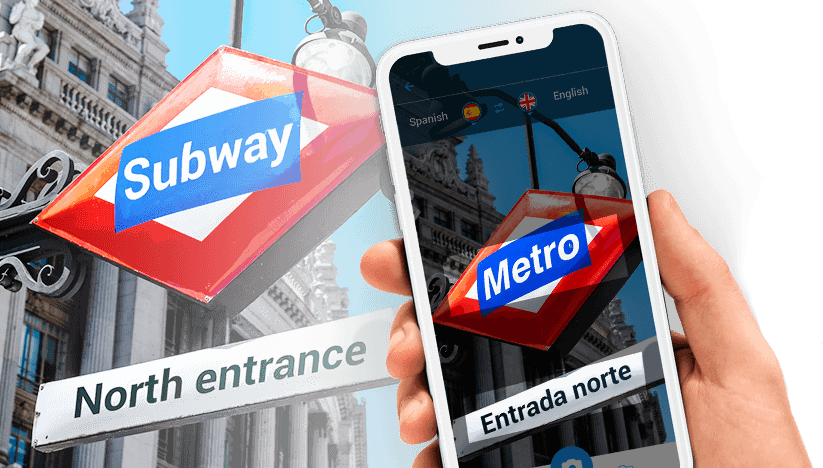
Is listening comprehension in a new language still your biggest challenge? Do you attend language classes every Thursday afternoon and still can’t understand half of what people are saying? Thought you were fluent—until you traveled abroad and hit a wall? Don’t worry—you’re not alone! This is completely normal, and it has more to do with “tuning your ear” than with how much vocabulary you know.
As you’ll see, listening comprehension is one of the toughest parts of learning any language. That’s why so many people feel frustrated when they step out of the classroom and into the real world. But that doesn’t mean your language lessons were a waste of time. You just need a few extra tools and techniques to finally make everything click.
And today, we’ll introduce you to a powerful tool that can truly rescue you in those “SOS” moments. Get ready to discover how to use Talkao’s real-time translator—your personal digital interpreter—to improve listening comprehension during both classes and travel experiences.
Why is listening comprehension so difficult for me?
This is one of the most common questions language teachers hear every day. And the usual answer tends to go something like this: “The more you practice, the better your audio comprehension will become.” While that may sound a bit discouraging to someone still learning… it’s absolutely true!
The challenge with listening comprehension is that it’s a lot like learning to ride a bike or play the violin. There’s really no other way to master it than by practicing over and over again.
In other words, listening skills aren’t something you can learn from a book. Nor can you buy them in a store. It’s a slow, gradual, scalable, and cumulative process. The more you expose yourself to spoken language, the more your brain adapts and improves. So, yes—it can be frustrating, but it’s one of those things you only get better at by doing.
But why is that the case? The answer lies in your brain, and you’re about to find out why.

The accuracy of audio translation: An incredible brain process
Every day, you perform extraordinary tasks without even realizing it. Think for a moment about driving. You move from place to place with ease, rarely stopping to consider the immense coordination it requires—your hands and feet working together, recognizing obstacles, even predicting other people’s behavior. This physical and mental effort happens naturally, almost without thought.
The same thing happens with language—even your native one. Yes, understanding your own language involves a massive cognitive effort. Even reading this article requires an extraordinary mental process—almost magical, if we may say so. But since it’s part of your daily life, your brain “hides” the effort from you. What does that mean? Let’s break it down.
The ear-brain connection and the process of listening comprehension
Imagine for a second that you were fully aware of every process involved in a simple conversation with a friend. What happens in your brain is like a high-speed factory in motion. Inside that factory, millions of workers—your neurons—are operating simultaneously and in perfect sync. And they do all this in milliseconds!
Every time someone speaks to you, they produce a sound that stands out from background noise. Human voices have a unique and recognizable resonance. We can easily distinguish a voice from surrounding sounds—and more impressively, we can recognize the voice of someone we love among hundreds.
This ability is one of the most remarkable traits of human evolution. While animals can make sounds, humans are the only species capable of articulating them into complex messages. Let’s see how this works.
The “journey” of the voice to the brain
As we’ve seen, the human voice is easily recognized amid background noise. Even more impressively, we can identify someone’s voice instantly, especially if it’s familiar. But here’s the fascinating part: we can also instantly recognize our native language.
Imagine your eyes are covered and you’re surrounded by different sounds. In a split second, you’d know:
- A human voice is speaking.
- It’s in your language.
- And it’s a friend talking to you.
But the most astonishing part? You actually understand what’s being said.
It’s almost like your ear comes with a built-in real-time translator. The accuracy of audio translation from sound to message is a brilliant cognitive feat. Yet it happens so quickly and so often that we’re barely aware of it.
To truly appreciate this incredible process, let’s visualize it using a simple comic-strip analogy. Imagine speech bubbles above the characters. Here’s how a typical conversation unfolds:
Your friend speaks
Thanks to voice identification and audio translation accuracy, your brain immediately detects that it’s a human voice. It recognizes who’s speaking and prepares to process the message.
The voice reaches your ear
In the tiny fraction of a second it takes for sound to travel to your ear, your brain’s auditory system activates. This part of the brain, trained over years of exposure, pulls up memory banks that link sounds to meaning.
The message is captured
Your brain knows certain sounds represent words—verbs, nouns, pronouns, and so on. Even if you don’t consciously know every grammar rule, your brain intuitively understands the structure of language and decodes the message.
Tone, inflection, and accent are detected
During this “journey,” your brain also picks up on tone and emotional inflection. You instantly know if the speaker is angry, sad, or happy. How many times has someone asked if something’s wrong—just based on your voice? The emotion is often louder than the words.
Your brain prepares to assimilate the message
As the voice travels to your brain, the message is translated and stored. Each sentence is analyzed and mentally “transcribed,” giving it meaning and emotional weight. At this point, what was once just sound has become a specific message.
Your response is formulated
Every sound that enters your brain triggers a cognitive and emotional reaction. It might spark laughter, tears, or any number of feelings depending on context. Most commonly, though, your brain prepares a verbal reply, often with accompanying gestures or expressions.
One simple message can ignite a storm of responses throughout your entire being. That’s the power of listening comprehension.
But here’s the catch: all of this happens in the language you learned from birth. Do you see now why achieving perfect audio comprehension in a second language is such a challenge? Not quite yet? Let’s keep going.
The complexity of listening comprehension in a second language
Everything we’ve discussed so far leads to one main point: listening comprehension is usually an automatic process. In other words, it happens subconsciously—in the background, as tech folks would say. You don’t see it, feel it, or even realize it’s happening. But trust us, it’s there.
You don’t notice it because your brain has learned to manage it through years of practice. From birth, you start recognizing your mother’s voice over your siblings’. You know a dog’s bark doesn’t require a response. Later, as you begin to speak, your parents and teachers help you refine your listening comprehension skills. You do it so naturally, it feels as easy as breathing or walking—simple and logical.
The real challenge begins when automation breaks down
And here’s the big issue: all of that automation falls apart when you try to comprehend a second language. And when it does, the effect can feel catastrophic. Your brain, which is used to receiving, processing, and understanding sound, suddenly becomes useless. No matter how hard it searches through your memory banks, it can’t find a link between what it just heard and what it means.
Your brain’s vanity and its rebellion against the unknown
Psychologists often describe this state of confusion as cognitive dissonance—a mental discomfort that arises when your brain doesn’t have an answer. And as you may already know, this little processor in your head has quite the ego. When it doesn’t know what to do, it often shuts down, goes into conflict mode, or even outright rejects the input.
That’s why learning a new language is really about training your brain to manage its own ego. You’re helping it understand that nothing is broken—it’s just hearing something it doesn’t yet recognize. And more importantly, it needs to know that a solution is coming soon.
In other words, not understanding is simply your brain facing one of its biggest internal battles. That’s why a lack of accuracy in audio translation is most noticeable when you’re not familiar with the language. The only way to fix it is through exposure, training, and knowledge acquisition—along with every bit of help you can get.
So, how can you improve? Let’s take a look at some practical tips.

Improve your listening comprehension skills through practice
As you’ve seen, developing listening comprehension in a new language is like going back to square one. In many ways, it’s similar to the process you went through when learning to speak and communicate as a child. But here’s the good news: you’ve done it before!
In other words, your brain already knows how to distinguish meaningful words from random sounds. It understands that by feeding its internal database, it can associate each sound with a message. The infrastructure is already in place—it just needs to be adapted to a new context: a new language.
That’s why many linguists compare learning a foreign language to “brain growth.” While your brain doesn’t grow physically, it certainly expands its capabilities. And that means you already have everything you need to boost your accuracy in audio translation. All you need to do is increase its processing speed. The key? A smart strategy that really works. Let’s explore it.
Increase your exposure to the new language
Surprisingly, the brain has an incredible capacity for adaptation. However, it tends to be cautious—if you don’t push it, it won’t change. That’s why it’s essential to help your brain understand that this new language is safe. In other words, you need to expose yourself to it as much as possible.
Here are a few effective ways to do that:
- Enroll in a language school or academy and begin structured lessons. This is one of the best approaches, as it provides a strong foundation and formal instruction.
- Travel to a country or region where the language is spoken natively. This is known as a full-immersion experience, and it’s incredibly effective.
- If traveling isn’t an option, connect with native speakers in your community. Conversations in real-life settings help reinforce natural language use.
- Watch movies, listen to music, podcasts, or any multimedia content in the target language. The more you listen, the better.
These options aren’t mutually exclusive—you can do all of them at once! Go to class, talk to locals, and stream foreign content. Every little bit helps.
Use translation technology and your own digital interpreter
Today, AI is transforming how we learn and understand languages—especially in the field of listening comprehension. The accuracy of real-time audio translation tools has reached incredible levels, and the best part is: you have access to it right in your hand.
With apps like Talkao, you can translate any spoken audio into your own language instantly. This real-time capability allows your brain to train faster, adapting to sounds and meanings at a much higher speed than traditional methods alone.
AI-powered translation tools act as a personal interpreter that’s always available. Talkao, for instance, allows you to improve your listening accuracy in over 125 languages, simply by using its features.
And that’s not all—these tools can also help you expand your vocabulary. Thanks to Talkao’s text translation, image translation, and live video functions, you’ll gain exposure to new words and phrases daily.
Each new word you learn gets you one step closer to real-time comprehension. Sooner than you think, you’ll be able to understand everything around you—and even speak like a native.
Agustín Gutiérrez is a writer, content editor, and copywriter with over 15 years of experience in various industries and corporate communication projects. He has played a key role in creating blogs, news pages, and press releases for some of the most prestigious and globally renowned brands. His work philosophy is centered on meeting readers' demand for content that is both highly useful and practical. As a result, Agustín produces high-value content that is informative, engaging, and designed to captivate his audience.












Newsletter